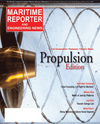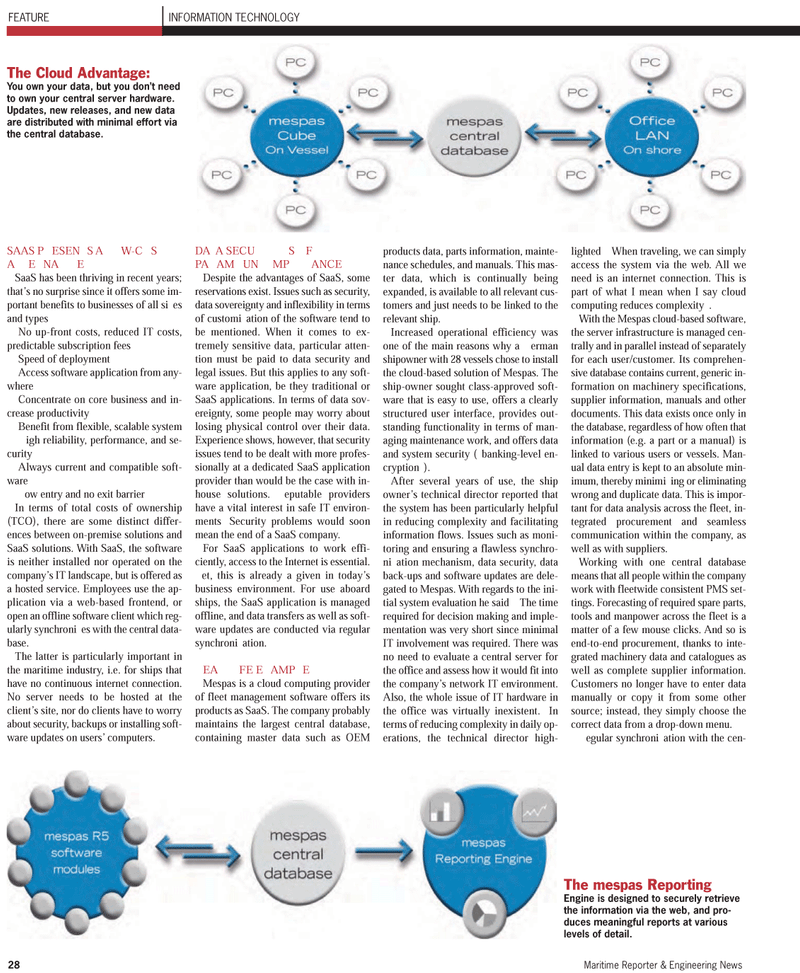
Page 28: of Maritime Reporter Magazine (September 2011)
Marine Propulsion Annual
Read this page in Pdf, Flash or Html5 edition of September 2011 Maritime Reporter Magazine
SAAS PESENS A W-CS AENAE SaaS has been thriving in recent years; that?s no surprise since it offers some im- portant benefits to businesses of all sies and typesNo up-front costs, reduced IT costs,predictable subscription feesSpeed of deployment Access software application from any- whereConcentrate on core business and in- crease productivity Benefit from flexible, scalable system igh reliability, performance, and se- curityAlways current and compatible soft- ware ow entry and no exit barrier In terms of total costs of ownership (TCO), there are some distinct differ- ences between on-premise solutions andSaaS solutions. With SaaS, the software is neither installed nor operated on thecompany?s IT landscape, but is offered as a hosted service. Employees use the ap- plication via a web-based frontend, oropen an offline software client which reg- ularly synchronies with the central data- base.The latter is particularly important inthe maritime industry, i.e. for ships that have no continuous internet connection. No server needs to be hosted at the client?s site, nor do clients have to worry about security, backups or installing soft- ware updates on users? computers. DAA SECU S F PAAMUN MPANCE Despite the advantages of SaaS, some reservations exist. Issues such as security, data sovereignty and inflexibility in terms of customiation of the software tend to be mentioned. When it comes to ex- tremely sensitive data, particular atten- tion must be paid to data security andlegal issues. But this applies to any soft- ware application, be they traditional or SaaS applications. In terms of data sov- ereignty, some people may worry about losing physical control over their data. Experience shows, however, that security issues tend to be dealt with more profes-sionally at a dedicated SaaS applicationprovider than would be the case with in- house solutions. eputable providers have a vital interest in safe IT environ- ments Security problems would soon mean the end of a SaaS company. For SaaS applications to work effi- ciently, access to the Internet is essential. et, this is already a given in today?s business environment. For use aboard ships, the SaaS application is managedoffline, and data transfers as well as soft- ware updates are conducted via regular synchroniation. EA FE EAMPE Mespas is a cloud computing provider of fleet management software offers its products as SaaS. The company probably maintains the largest central database, containing master data such as OEMproducts data, parts information, mainte-nance schedules, and manuals. This mas- ter data, which is continually beingexpanded, is available to all relevant cus- tomers and just needs to be linked to the relevant ship. Increased operational efficiency was one of the main reasons why a erman shipowner with 28 vessels chose to install the cloud-based solution of Mespas. The ship-owner sought class-approved soft- ware that is easy to use, offers a clearly structured user interface, provides out- standing functionality in terms of man-aging maintenance work, and offers data and system security (banking-level en- cryption). After several years of use, the ship owner?s technical director reported that the system has been particularly helpfulin reducing complexity and facilitating information flows. Issues such as moni- toring and ensuring a flawless synchro- niation mechanism, data security, data back-ups and software updates are dele- gated to Mespas. With regards to the ini- tial system evaluation he said The time required for decision making and imple-mentation was very short since minimal IT involvement was required. There was no need to evaluate a central server for the office and assess how it would fit into the company?s network IT environment. Also, the whole issue of IT hardware in the office was virtually inexistent. In terms of reducing complexity in daily op- erations, the technical director high-lighted When traveling, we can simply access the system via the web. All we need is an internet connection. This is part of what I mean when I say cloudcomputing reduces complexity. With the Mespas cloud-based software, the server infrastructure is managed cen- trally and in parallel instead of separatelyfor each user/customer. Its comprehen- sive database contains current, generic in- formation on machinery specifications, supplier information, manuals and otherdocuments. This data exists once only in the database, regardless of how often that information (e.g. a part or a manual) islinked to various users or vessels. Man- ual data entry is kept to an absolute min- imum, thereby minimiing or eliminating wrong and duplicate data. This is impor- tant for data analysis across the fleet, in-tegrated procurement and seamless communication within the company, as well as with suppliers. Working with one central database means that all people within the company work with fleetwide consistent PMS set- tings. Forecasting of required spare parts, tools and manpower across the fleet is a matter of a few mouse clicks. And so is end-to-end procurement, thanks to inte-grated machinery data and catalogues aswell as complete supplier information.Customers no longer have to enter data manually or copy it from some other source; instead, they simply choose the correct data from a drop-down menu. egular synchroniation with the cen- 28Maritime Reporter & Engineering News INFORMATION TECHNOLOGY FEATURE The mespas Reporting Engine is designed to securely retrieve the information via the web, and pro- duces meaningful reports at various levels of detail.The Cloud Advantage: You own your data, but you dont need to own your central server hardware. Updates, new releases, and new data are distributed with minimal effort via the central database.

 27
27

 29
29
